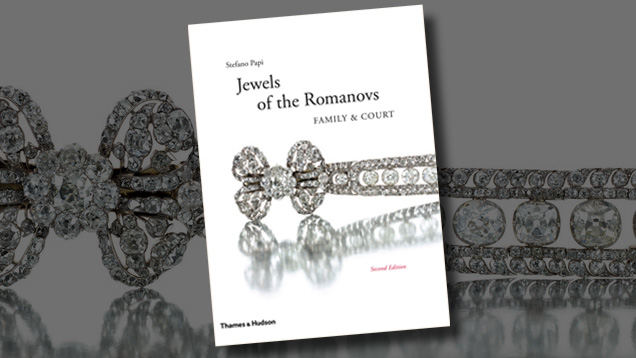Books: Jewels of the Romanovs: Family & Court

For the reader who enjoys the history of Imperial Russia, this book offers a rich treasure trove of archival photos of the Romanovs and members of their court. The photos show not only the formal life of the royals but also intimate everyday scenes, giving a glimpse into the personalities behind the titles. Papi delves into the unique people who populated the royal circles, as well as the artists whose work adorned them. This book gives the reader an intimate look into the lives and personalities of early 20th century Europe. Navigating the family tree of European royal houses is no easy task, but Papi does a fine job of connecting the dots as he introduces the various characters. The history buff will enjoy both the images and the unique, colorful stories the author weaves.
For those interested in gems, this book offers archival and modern photos of some of the most beautiful and impressive jewels ever created. These are supplemented with compelling descriptions and stories of the jewelry’s provenance. The reader is taken on an incredible journey of intrigue and romance that crosses the globe and includes such stones as the 189.62 ct Orlov diamond in the Imperial Scepter, as well as the 400 ct spinel in the Great Imperial Crown. Pieces of jewelry are often accompanied by an archival photo or painting of the owner wearing the piece. Included in this volume is a beautiful color photo of a kokoshnik, or traditional Russian headdress, made with diamonds and large cabochon emeralds by the court jeweler Bolin. A black-and-white photo shows Queen Marie of Serbia wearing it, along with diamond earrings weighing 20 carats each. Over the years, some pieces have been lost or broken up to make other pieces, so these illustrations serve as a historical record.
The book is illustrated with masterpieces by the greatest jewelers of the time: Cartier, Bolin, Boucheron, Chaumet, Lalique, and, of course, the venerable Fabergé. They all catered to the courtiers of St. Petersburg. One of the prominent personalities at court was Maria Pavlovna, the Grand Duchess Vladimir. Married to Grand Duke Vladimir, brother of Alexander III, she was known for her collection of magnificent jewels. There was not one prominent jewelry house in St. Petersburg, Paris, or London that did not know her. She was one of their most important clients, famous for her glorious balls and dinner parties that rivaled even those at the Imperial court.
During the Russian Revolution, Empress Alexandra managed to get her major jewels out of the country. Some smaller treasures, including Fabergé cigarette cases and her husband’s cuff links, were stuffed into pillowcases and smuggled by a friend to the Swedish embassy. They remained stored in the basement of a government building in Stockholm until they were discovered in 2009. Sotheby’s sold off this treasure trove, along with the two pillowcases, in November of that year. One of the book’s more memorable photos shows several of the Fabergé cigarette cases on top of the pillowcases. This adventure is just one of many that enhance the history of the jewels in this book.
Of course, the story of the Romanovs ended tragically. Papi devotes the final two chapters to the last days of the royal family, documented in photos, and the final dispersal of royal treasures by the Bolsheviks. Many pieces made their way into American collections through dealers such as Wartski in London and Armand Hammer in New York. If only these jewels could speak, what stories they might tell! Stefano Papi has created a well-researched, beautifully illustrated book that gives them voice.



